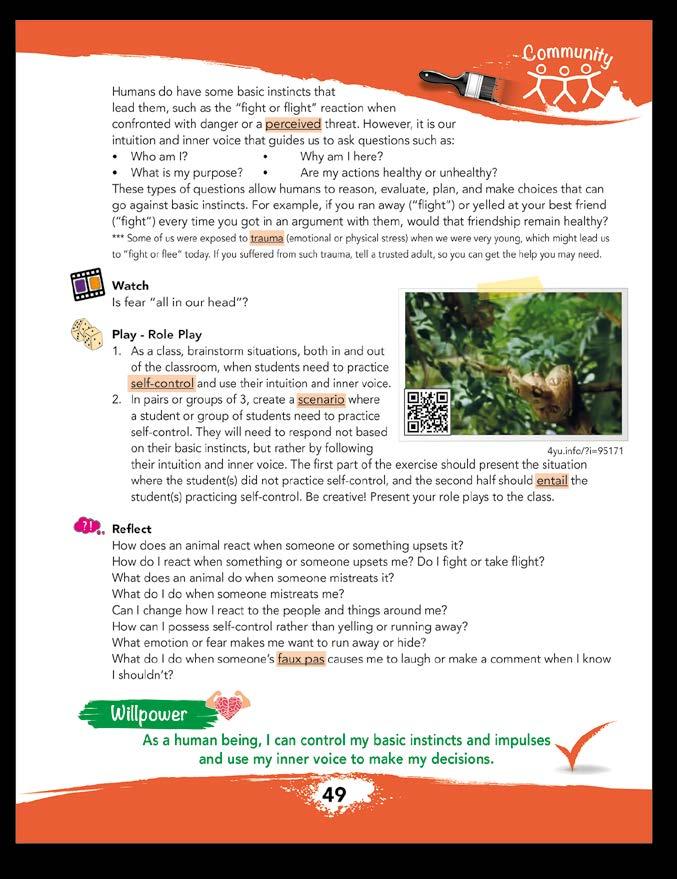
4 minute read
Lesson 3: The Way I Feel
Materials
My Best Me textbook, journal, paper, pencil, audiovisual equipment *Book Suggestion: What Were You Thinking? Learning to Control Your Impulses by Bryan Smith and Lisa M. Griffen
Advertisement
Resources
Student Worksheet: 4yu.info/?i=V598518 Family Engagement: 4yuinfo/?i=V598568 Video: 4yu.info/?i=95171
Glossary
architect, complex, intuition, inner voice, mate, extremely, exhibit, threatened, evaluate, perceived, trauma, self-control, scenario, entail, faux pas
Motivation
Humans and animals share characteristics such as the need to eat, sleep, rest, exercise, and co-exist with other living creatures. On the other hand, there are also many characteristics that set us apart. Humans are a unique species capable of making valuebased decisions (i.e. free will). This gives us the ability to choose either to nurture and protect life (being fruitful, purposeful, healthy, constructive, creative, genuine, loving, etc.), or take action against it (being unproductive, angry, unhealthy, destructive, disingenuous, hateful, etc.). These attributes not only afford humans greater mental capacity, but also a conscience, which guides our decisions regarding how we relate to ourselves and others. This higher mental and emotional functioning is what allows us to form complex relationships, and our decisions determine whether they are loving ones or the opposite. Our choices have farreaching consequences, for we are capable of evaluating the past and present when we plan for the future. Students should recognize that an animal’s instincts and a human’s intuition are actually very different. For example, within the complexity of human intuition lies the ability to make choices and display selfcontrol. The students will explore various issues that require self-control and identify ways to practice self-control skills.
Goal
The students will identify various skills and strategies needed to practice self-control, and understand how that makes them more emotionally and ethically more complex than animals.
Pathways
Observe: Students will observe various animal homes and identify who created them. The purpose of this section is for students to begin to compare and contrast animals with humans. Of course, there are similarities, but this lesson is focused on key differences that allow humans to function at more complex ethical and emotional levels than animals do. Write: Students will have the opportunity to comment on their observations. They will also discover that some of the animal homes are more complex than others and require more skill to construct. The purpose

of this section is help the students recognize the profound difference between humans and animals in our ability to regulate our basic instincts and behavioral impulses. Understand: Please read this section with the students. Lead a brief discussion on the differences between animals and humans, particularly in regard to the complexity of the human brain. Talk about the “fight or flight” (and even the freeze) instinct that exists in virtually all living creatures, humans included. What are the factors that determine fight or flight for humans? Students may bring various opinions and background knowledge regarding human intuition, inner voice, conscience, sixth sense and the spiritual realm to explain the decision-making process that exists in humans as opposed to animals. Students may bring up personal experiences, including physical encounters, narrow escapes, or the belief in a higher power. Be sure to encourage free and open discussion without making judgments, no matter what their personal beliefs are. If the debate becomes heated or veers off course, steer the students back to the purpose of the lesson (i.e., developing healthier means of self-control). Role Play: Students will roleplay various situations where impulse control would be preferable to acting on raw instinct, and why. Allow ample time for students to switch roles in order to practice both sides of the situation. Discuss the various scenarios as a class, with a focus on self-control strategies and the role of intuition (or adhering to their inner voice). Some skills and strategies for practicing self-control are listed below and can help lead discussion. Strategies for Self-Regulation: goal trackers; impulse control journals; habit trackers; adjusting time to complete tasks; counting to 3 before speaking or acting (or to 10, if you are really angry or triggered); self-rewards; acting out situations; positive thought journals; creating a schedule; breaking down large tasks into smaller pieces; selftalk. Reflect: The workbook questions allow the students to analyze their thoughts and responses when placed in potential scenarios. Encourage the students to be as honest as possible in their journal time. Remind them that there are no right or wrong answers. Their journal time is an opportunity to reflect, grow, and create self-improvement goals. Help them recognize the power contained in their personal choices, and to realize their choices lead to results and consequences that they will either enjoy or regret.
Willpower
It is important for children to understand that they can control what they think, say and do by being aware of their actions and practicing self-control.





